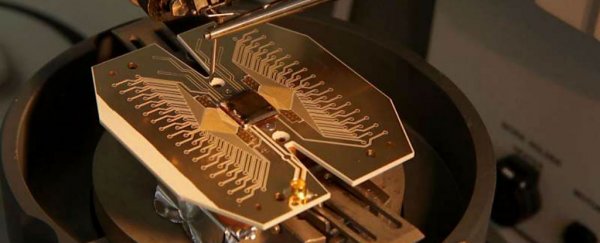Scientists chasing the dream of quantum computing - technology that would grant us unprecedented processing power - just got their biggest break yet, because the first ever open-source blueprint for a practical quantum computer has been revealed.
This blueprint, which outlines how to make a quantum computer the size of a football-pitch, claims to solve previously 'uncrackable' problems using existing technology - meaning the revolutionary technology could be finally within our reach.
"[W]e are now publishing the actual nuts-and-bolts construction plan for a large-scale quantum computer," one of the team, Winfried Hensinger from the Ion Quantum Technology Group at Sussex University in the UK, told The Independent.
"Life will change completely. We will be able to do certain things we could never even dream of before."
In case you're not up to speed with the whole quantum computing saga, the technology was first theorised by Nobel prize-winning physicist Richard Feynman in 1982.
It's yet to be built in any kind of practical form, but it's set to revolutionise how we process massive amounts of data in the future.
Unlike the computers of today, which are limited to the 1s and 0s of binary code bits, quantum computers are based on qubits. Thanks to the 'spooky' quantum effect known as entanglement that occurs in matter at its smallest scale, each qubit can take on the state of 0, 1, or a 'superposition' of the two.
So rather than having bits that can only be 1 or 0 at any given moment, qubits can be anything and everything at once. This means they can perform many calculations simultaneously, giving them the potential for unprecedented processing power.
How unprecedented? Well, Google has claimed its D-Wave 2X 'quantum computer' is 100 million times faster than your laptop, and the general consensus is it's not even a proper quantum computer - an actual quantum computer has the potential to be even more transformative than that.
While teams all over the world are racing to build the first ever legit quantum computer - the process has been slow, because harnessing the strange effect of entanglement is no easy task.
So far, scientists have barely been able to build devices with more than 10 or 15 qubits, and that's not going to be much use to anyone.
"Lab machines suffer from a kind of drop-out called decoherence, where qubits lose their ambiguity and become straightforward 1s and 0s - a technical obstacle to building practical quantum computers," Paul Rincon explains for BBC News.
"With our concept, we include a method to correct these errors, allowing the possibility to build a large scale device," Hensinger told him.
"For some of the really exciting applications of quantum computers, such as inventing new drugs, or understanding the fabric of reality itself, understanding the Universe, designing new materials, instead of 10 or 15 quantum bits, I need a lot more qubits, maybe up to 10 billion quantum bits eventually."
Hensinger and his team say their new blueprint draws on existing technology to overcome the main challenges that have been holding back the development of practical, large-scale quantum computers that could actually find use outside the lab.
The approach is to use ions (charged atoms) trapped in magnetic fields as the qubits, and these would exist in a system of thousands of square, hand-sized modules.
These square modules would be interchangeable - able to be replaced or added to at will - which means you could theoretically build a quantum computer as big as you like.
Each of these modules would contain 2,500 or so ion qubits, and the magnetic fields would shield them from interference and preserve their quantum states.
When the computer is fired up, operations would be performed by interactions between the ions, facilitated by shifting the modular grid in a way that gently guides them into each other. Think Pacman moving about his maze of randomly generated paths.
The team explains that previous quantum computer designs have proposed using fibre optic connections to link up the individual computer modules, but their blueprint uses electric fields to transport the ions from one module to the next.
They say this approach allows 100,000 times faster connection speeds between individual quantum computing modules, and allows the computer to operate at room temperature, unlike alternative designs that required superconducting materials cooled to impractical temperatures.
Another improvement the team claims to have made is that, rather than using individual lasers to keep the ion qubits in place, they instead would run a field of microwave radiation across the entire computer system.
"To tune individual qubits in and out of interaction with the wider field, they need only apply a local voltage," Elizabeth Gibney explains for Nature.
The blueprint, which is now available for any team of researchers to use, can be used to build a quantum computer that could fill a large building.
Hensinger and his team say they're hoping to have their own version up and running in just two years.
"This is not an academic study any more, it really is all the engineering required to build such a device," he told The Independent.
At this stage, let's just say we're skeptical, but cautiously excited - a sentiment echoed by other researchers in the field.
As Andrea Morello, a physicist from the University of New South Wales in Australia who's been building his own quantum computing technology, told Nature, while the blueprint poses some of its own tough challenges, "I do think this is a landmark paper, and it will be very influential in the community for many years ahead."
The research has been published in Science Advances.
